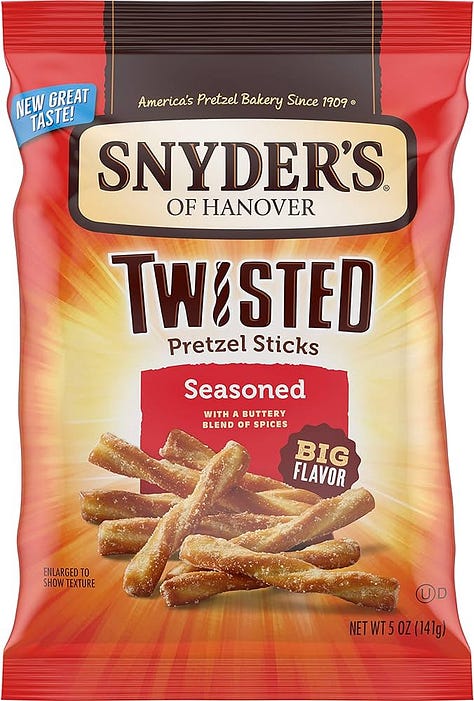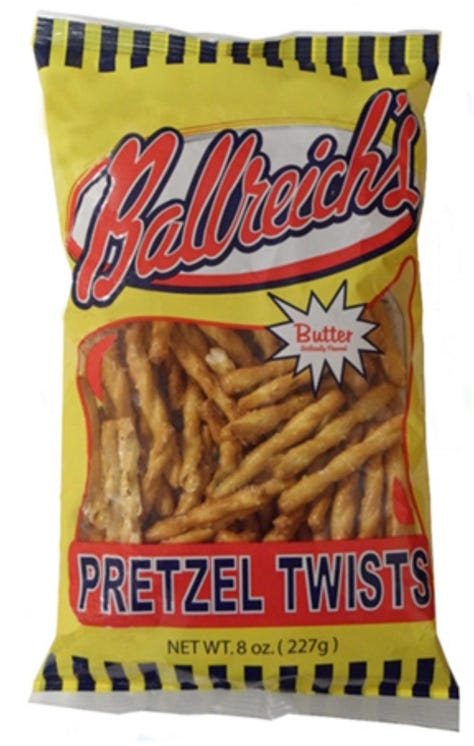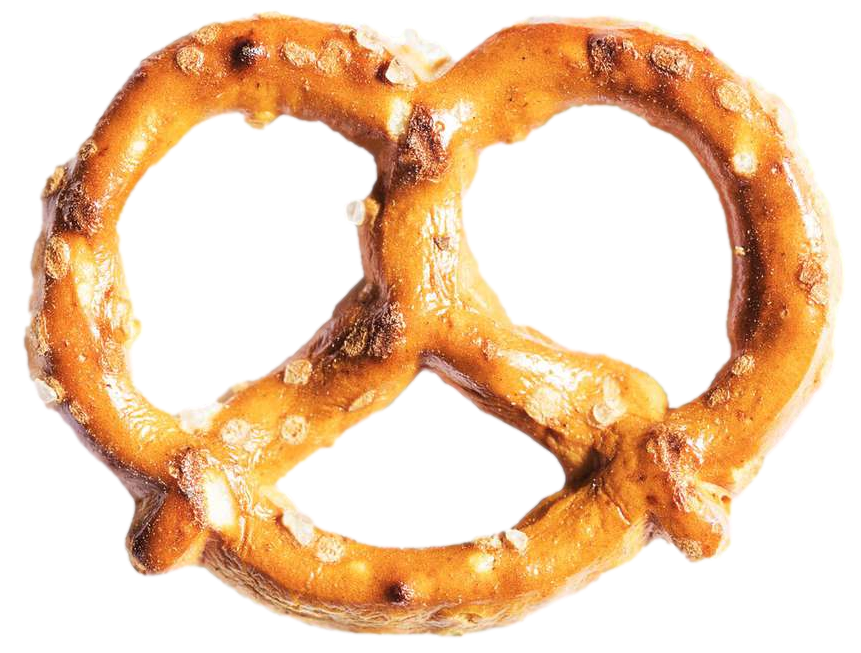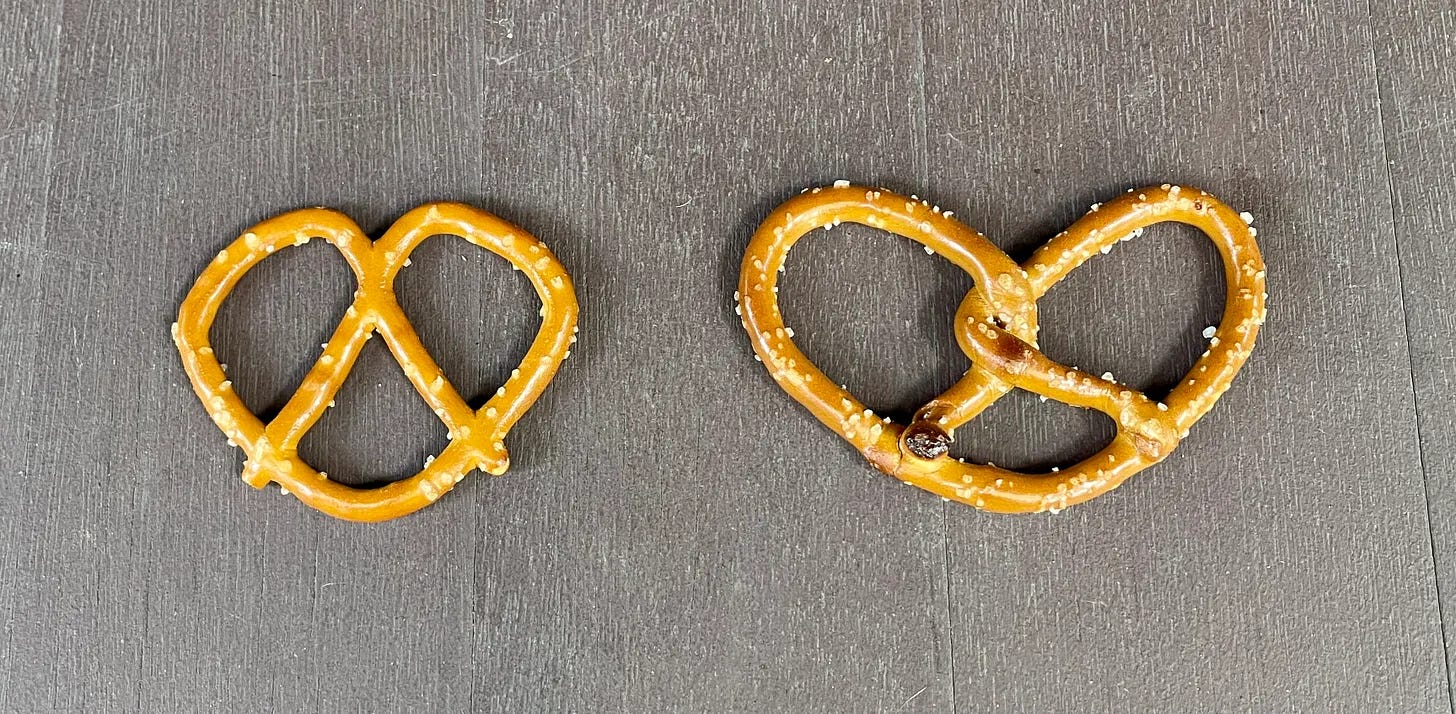Pretzel Logic: The Twists and Turns of an Iconic Product
The language of this classic snack has slowly been corrupted.
Yesterday I used a bag of pretzels to illustrate the odd packaging phenomenon of “Enlarged to Show Texture” photos that haven’t actually been enlarged. As I worked on that piece, I realized that there was another pretzel-related issue I wanted to delve into, so I’m going to do that today.
Let’s start here: What two things do all of the pretzel packages shown above have in common? I will tell you:
They all describe their respective pretzel products as “twists.”
Despite this wording, they all have photos showing pretzels that do not twist in the center.
Some quick background: Pretzel “twists” have long referenced the familiar German or Pennsylvania Dutch pretzel shape, which is created by taking a long, thin length of dough and tying it into a little knot with a twist in the center, like this:
If you follow the procedure shown in that video clip, you get pretzels with a twist in the middle, like this:
But if you look at the pretzels shown at the top of this article, you’ll see that while the their left and right sides loop around and meet in the center, they do not actually twist. Instead, they look like this:
To be sure, there are plenty of pretzels on the market that do include the center twist. The thicker variety of hard pretzels, for example (sometimes simply called “hards”), are still twistified:
And soft pretzels, whether purchased from a street vendor, an Auntie Anne’s airport kiosk, or your grocer’s frozen foods aisle, likewise have the twist:
Mass-produced thin/hard pretzels used to have the twist as well. Why don’t they anymore? Because most thin/hard pretzels are now extruded, not twisted. This means the dough isn’t rolled into a thin length and then manipulated into a pretzel shape; instead, the dough is forced through a pretzel-shaped metal die, which doesn’t allow for the center twist. Here are two short video clips showing the process — the first one provides a good view of the basic extrusion process on a small scale, and the second one shows a large pretzel factory:
You can see how the extrusion process really puts the “mass” in mass production. It also explains why we now see so many pretzel shapes that would have been impossible in the pretzel industry’s pre-extrusion days — waffles, wheels, rings, Christmas trees. As long as you have the proper-shaped die, you can have the corresponding pretzel shape. (Extrusion is also used to make pasta, cereal, certain candies, and a lot more. Additional info here.)
I’m not sure exactly when extrusion began killing off the pretzel twist, but it definitely happened within my lifetime. When I was growing up in the 1970s and ’80s, supermarket pretzels still had the twist (I can say that with some certainty because the twist was my favorite part to eat), but I began noticing some twist-free pretzels in the 1990s. The tipping point presumably came soon after that, and extrusion’s triumph is now almost complete.
But not quite — there’s still one holdout. The venerable pretzel brand Bachman, which was founded in 1884 and was acquired in 2012 by fellow Pennsylvania snack purveyors Utz, still makes pretzel twists that are worthy of the name.
Ah, that’s more like it. So much more more satisfying than the extruded style! The Bachman website even says, “Unlike others, we make our delicious Bachman Twist Pretzels the old-fashioned way — by actually twisting them!”
Here’s a side-by-side comparison — extruded Rold Gold on the left, twisted Bachman on the right. It’s not even a fair fight:
Note how the extruded pretzel seems comparatively flat. That’s because, as we saw in the videos, it was sliced off the die by a big blade. But the twisted pretzel began life as a cylinder of dough, so its contours are still tubular — much better.
The twist’s mass-production method is more fun, too. Check this out (the pretzels in this video are bigger than Bachman’s twists, but the process is the same):
How cool is that?! I ask you: If you could take a factory tour of just one pretzel manufacturing facility, wouldn’t you choose the twist production line over the extruder?
With all of this in mind, I don’t think you should get to call your pretzels “twists” unless there’s an actual twist in the center. But that issue may soon be moot, because the snack industry is in the process of redefining what “twists” even means in a pretzel context. Most of the major brands now offer something like this:






Do you see the sleight of hand at work here? The manufacturers have essentially created an alternate pretzel-verse in which the term “twist” no longer refers to the classic looped-and-knotted pretzel shape but instead applies to pretzel sticks. Okay, so they’re sticks that have been twisted a bit, but come on — they’re still sticks!
There’s something vaguely Orwellian about this debasing of the language. First they call the extruded pretzels “twists,” even though they clearly don’t twist. Then they reassign “twists” to a completely different product, as if to say, “Look, you said you wanted ‘twists’ that actually twist, so here you go. You happy now?”
Following the letter of the law while corrupting the spirit of the law — now that’s twisted.
• • • • •
“Enlarged to Show Texture” Update
Remember all the products that were actually the same size as their supposedly “enlarged” photos? Here’s a particularly funny example:
(Big thanks to Mary Bakija for this one)
• • • • •
So … Very … Conflicted
Those of you who are familiar with some of my other work may know that I absolutely despise the color purple. So you can imagine the mixed feelings I experienced when I saw this photo of my Very Favorite Object rendered in my least favorite color (taken by my friend Jason LeDuc at a store-liquidation sale in Toronto). Some major cognitive dissonance!
An Important Note
Today marks the end of Inconspicuous Consumption’s “free trial” period. I’ll do one more free post later today (a “Bomp” update), but all subsequent IC posts will be paywalled after the first couple of paragraphs. If you like what you’ve seen here over the past several weeks, I hope you’ll consider supporting Inconspicuous Consumption with a paid subscription.
If you don’t like what you’ve seen here, or if you just don’t have the resources, of course I understand — no pressure. Thanks for reading.
Paul Lukas has been obsessing over the inconspicuous for most of his life, and has been writing about those obsessions for more than 30 years. You can contact him here.













This post is making me thirsty.
https://www.youtube.com/watch?v=yMe7mlRv8UE
I must admit I was hesitant as s Uni Watch subscriber as to your new direction. I must say you've hooked me with these wonderful articles and will stay on as a paid subscriber. I can't wait for all the twists and turns(sorry) of your future musings. Thanks for making my day a little brighter and for providing some good food for thought(sorry, again)